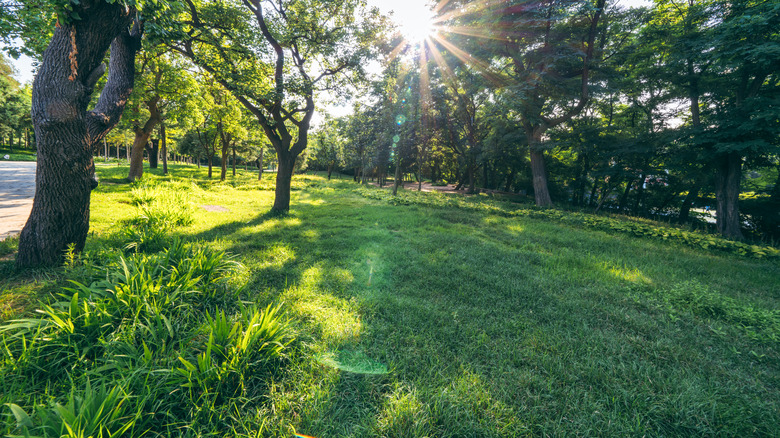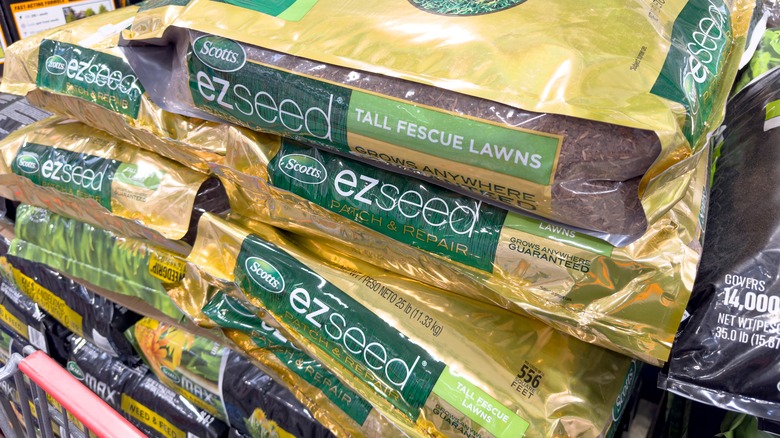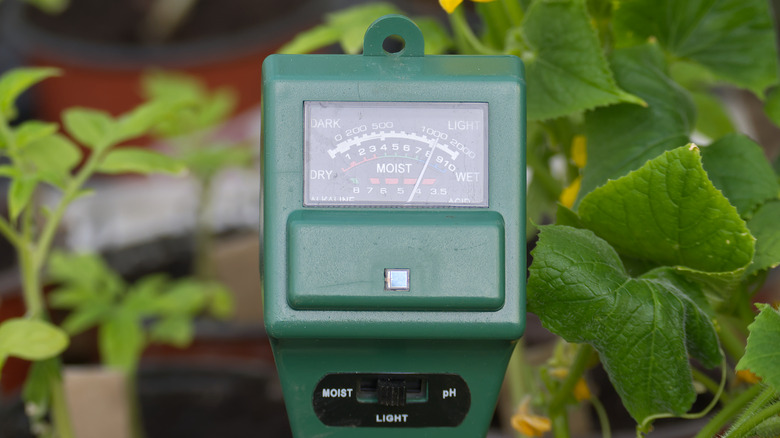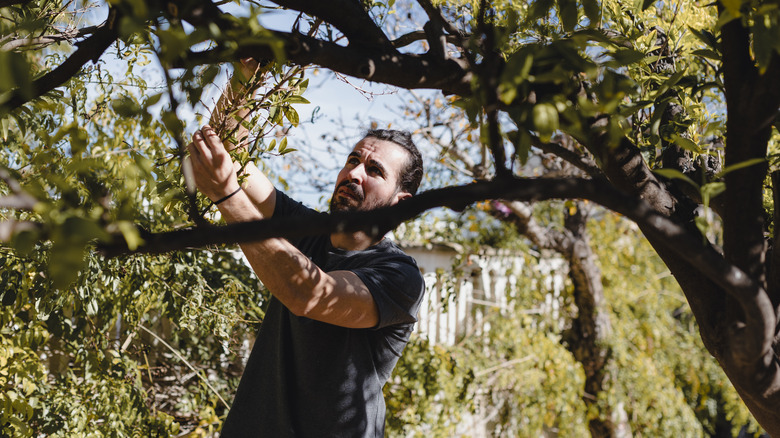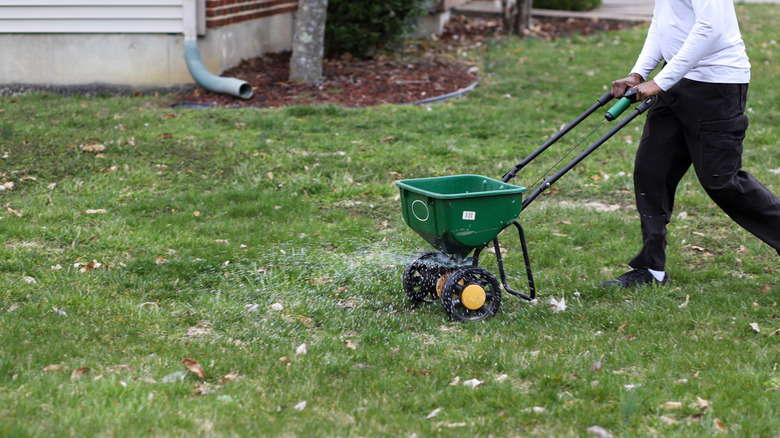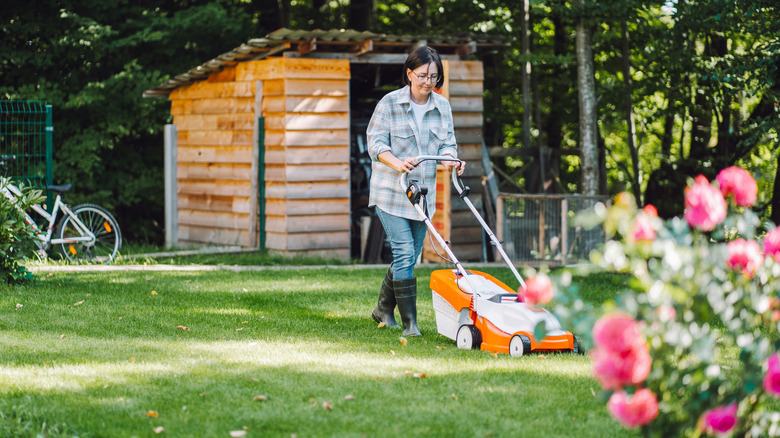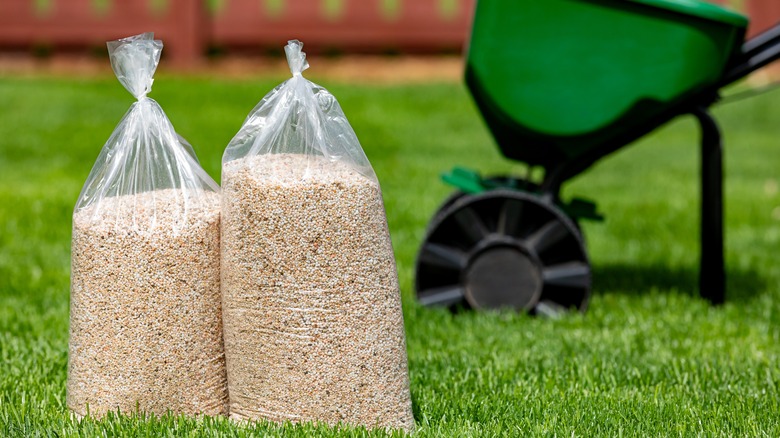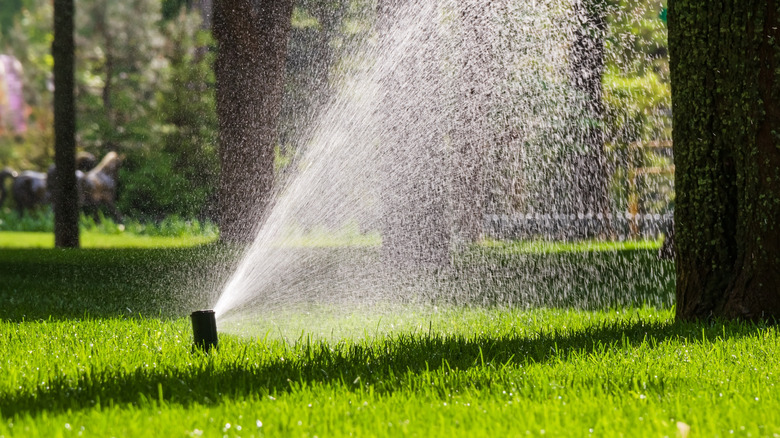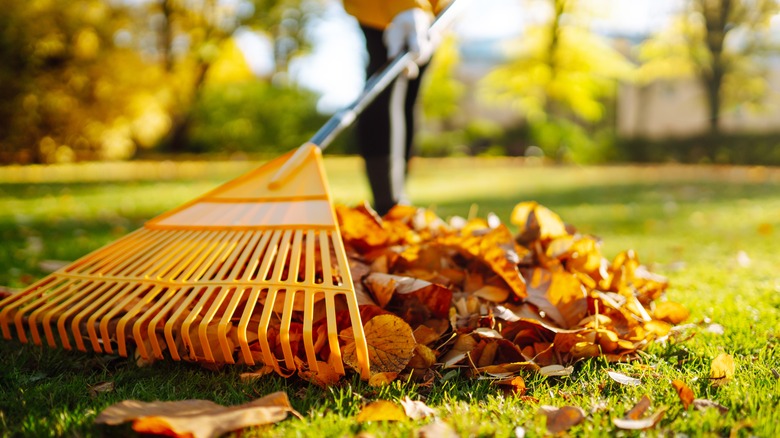9 Tips And Tricks For Growing Lush Green Grass In Shady Spots In Your Lawn
Big patches of cool shade offer idyllic spots to relax on hot summer days, whether you're tossing a ball to your dog or swinging in a hammock. Your grass? That's a different story. Most turfgrass varieties tend to do best growing in full sun — the majority of standard varieties need at least six hours of direct sunlight every day to thrive, although some can get by on four to five hours a day. Grass that grows largely in the shade is often thin and weak compared to areas with full sunlight. Even if you follow all the habits of people who keep their lawns lush and well-manicured, you'll likely have trouble growing a thick, dense lawn under your trees or in parts of the yard that are mostly shaded by large structures.
The main issue is the lack of sunlight — photosynthesis is much more of a challenge without it, and that process is needed for grass growth. If the shade comes from trees or shrubs, the issue could also be a lack of moisture and nutrients. The larger plants often soak up those essentials, leaving less for the grass growing below. Whatever the reason, you're working against nature to get turfgrass to thrive in shady areas.
While you may never have a lush carpet of grass in those zones, you can improve the quality by making some changes, starting with shade-tolerant grass varieties planted in amended soil and regular overseeding. Cutting back branches could let in a little more light to help. When it comes to lawn care, raising your mower blades, watering with care, cleaning up fall leaves quickly, and reducing nitrogen applications can all help your grass thrive. It's also beneficial to reduce foot traffic in shaded areas.
Choose a shade-tolerant grass variety suitable for your climate
If your lawn doesn't get the recommended four to six hours of direct sunlight, you might need to rethink the type of grass you grow there. With so many different types of grass seeds, there are options to suit various circumstances. You can choose shade-tolerant grass seed varieties that will grow in less direct sunlight. Switching to one of those options could give your lawn a fighting chance in a poor growing environment. Some turfgrass species grow with as little as two hours of direct sunlight per day. However, other shade-resistant options still need three to four hours to grow well. Fine fescues and rough bluegrass (Poa trivialis) are good choices. You can also find shade-tolerant mixes that lean heavily on fine fescues. Your climate and the environment in your yard will play a role in which shade-tolerant grass variety you should select. For example, if you live in a warmer climate, you'll want to use warm-season grass instead of cool-season grass, as the latter is better suited for yards in cooler northern climates.
To start, evaluate how much direct sun your lawn receives each day to choose a grass that matches the amount of sunlight that's available. Then, consider how much moisture the area gets. If the soil is drier, fine fescues will thrive, and for damper areas, consider rough bluegrass, which does better in more moist conditions. Fescues and rough bluegrass are cool-season grasses. If you need a warm-season grass, St. Augustine grass (Stenotaphrum secundatum) is typically the best choice for moist, shady sites. You may also be able to plant Zoysiagrass (Zoysia) successfully in areas with light to moderate shade, and once established, it's very tolerant to drought.
Improve the soil pH
A lack of sunshine already puts turfgrass at a disadvantage, but you can make up for that in other areas to help your yard grow a bit better. It starts with the soil that your grass is growing in. Soil acidity impacts how well the grass grows and could cause additional problems. For instance, overly acidic soil, especially in poorly draining areas that remain damp, could increase the chances of moss and algae growing in the lawn. For grass, the ideal soil pH is slightly acidic — ranging from 5.8 to 6.5. You may need to adjust the soil to reach that range for optimal grass growth.
Begin by testing the soil, especially if you've never done so before, and repeat the testing every three years or so to make sure the soil is still healthy, with the ideal pH. You can buy a range of testing options, including mail-in kits like the MySoil soil test kit, which analyzes several plant-available nutrient levels. Another option is a probe, like the Sonkir soil pH meter, which also measures light and moisture. Once you know the pH, you can take steps to fix soil acidity imbalances through adding amendments like lime or sulfur.
Let in more light by trimming branches if possible
When trees and shrubs create the majority of the shade in your lawn, you may be able to prune some of the branches to let in more light. Dappled sunlight will help the grass thrive better than deep shade. Removing lower branches could help with the shade and lower the relative humidity in the area by allowing more circulation. Since many common lawn diseases thrive in humid conditions, this change could improve the health of the grass. However, you don't want to just start cutting branches randomly or go too crazy with what you remove, as you could affect the health of the tree. As a general rule, you don't want to cut out more than a quarter of the branches with foliage.
Assess your trees to determine if pruning them is a good option. Maple, oak, and other dense-foliage trees are often good candidates for this solution. Contacting a certified arborist is a safe way to decide how much to prune and which branches you should remove. Reputable tree companies typically have certified arborists on staff to protect the health and integrity of trees when work is done. If you remove branches from your trees, remove the debris quickly to prevent damage to the grass. You can also thin out nearby shrubs to let more light filter in.
Overseed the shady lawn area when needed
Overseeding your shady lawn may be necessary to fill in the thin areas. The process involves adding more grass seed over an existing lawn. When well taken care of, the seeds grow into seedlings and fill in the gaps for a thicker lawn. If the soil is also compacted, combining overseeding with aeration can have a greater impact on the health of the grass. For the best results, wait until the fall to overseed your shaded lawn. Deciduous trees go dormant during the fall and winter, so they won't compete as much with the seedlings for sunlight, moisture, and nutrients. Mid-August to early September is an ideal time of year to overseed your lawn in most areas. If you prefer to overseed in the spring, do the task in April.
You want a clean, debris-free yard before overseeding to get as much contact as possible between the soil and the seeds. Aerate the lawn first if you're doing it at the same time. If you're not aerating and you're working with a small area, you can rake the patches you plan to overseed to loosen the dirt and allow for better contact with the seeds. Make sure you choose shade-tolerant grass, like fine fescue, for the overseeding process. Mow the grass to about 2 inches before applying the grass seed to expose more soil and reduce competition for nutrients. Spread the grass seed by hand or with a spreader, and keep the area moist until the seeds germinate.
Leave your grass higher when you mow
Grass growing in the shade struggles with photosynthesis due to the lack of sunlight. You can help the blades out by leaving more of them each time you mow. With more surface area left behind, the grass can soak up a bit more sunlight. The extra sunlight supports the energy production process, ensuring the grass makes the food it needs to thrive. Leaving the grass longer also supports root growth, allowing the plants to reach deeper to absorb the nutrients they need. In general, you never want to cut the grass lower than 3 inches in areas that are heavily shaded.
When you go to mow the shady parts of your lawn, move the blades up by ½ to 1 inch compared to the height of that species in sunny areas to give the grass a little extra surface area. Don't remove more than one-third of the grass blade each time you mow — that's standard for all lawn areas, but it's particularly important in shady areas where a major cut could cause excess stress and significantly reduce the surface area. To achieve that and maintain a 3-inch height, fire up the mower when the grass is about 4 ½ inches high. If you let it go a little longer, only cut off one-third of the height on that mow. Slowly cut down to your desired height by lowering your mower blade over a few mowing sessions.
Cut back on the nitrogen when you fertilize shady areas
If you fertilize your whole lawn the same way, you could be doing your shade-dwelling grass a disservice. Those areas typically don't need as much fertilizer overall, but it's particularly important to use less nitrogen in the area. Excess nitrogen encourages lots of vertical growth of the grass blades. That might seem like a good thing because it provides more surface area to soak up sunlight, but it pulls energy away from root growth, creating weaker plants overall. Applying smaller amounts of nitrogen can provide the grass with the nutrients it needs without sacrificing root health. Cutting back on nitrogen could also minimize lawn disease incidents and make the grass less susceptible to injuries from foot traffic.
When you fertilize your lawn, reduce the nitrogen content of the fertilizer by at least half compared to what you would put on grass growing in full sun. Aim for 1 or 2 pounds of nitrogen per 1,000 square feet — that's all you need for the entire growing season. The ideal time to apply the fertilizer is either in September or late October to early November. You can also use the lower-nitrogen fertilizer on the shady parts of your lawn in the spring.
Minimize foot traffic in shady areas
Heavy foot traffic is rough on even the hardiest grasses growing in ideal conditions. If your kids constantly play tackle football on your lawn or you frequently drive vehicles over the grass, you'll likely notice a decline in its health. Soil compaction is a common problem in areas with lots of heavy activity, making it more difficult for the roots to grow successfully. However, traffic control is often even more crucial in shady areas where grass is naturally weaker. Fine fescues, in particular, don't hold up under heavy activity, so they're better for out-of-the-way spaces.
Evaluate how you use the shady parts of your yard to reduce foot traffic in those sections. It's tempting to place lounging areas there, but that causes more foot traffic on the vulnerable grass. You might build a patio with a paver walkway leading to it if you want to enjoy the shade. That allows easy access to the seating area without unnecessary footsteps on the surrounding grass. If your pet frequently runs or plays in those areas, consider fencing them off or creating a separate fenced area for your pet to run and play in. In the fall, core aeration can help ease soil compaction from foot traffic in the shaded parts of your lawn.
Water grass in the shade deeply, but only when needed
Your grass may need supplemental irrigation, especially if trees block or soak up most of the water in the area. However, how you water is important for the survival of the grass. Shallow irrigation under trees encourages the tree roots to stay near the surface. That can cause competition for the grass. Deeper watering encourages both grass and tree roots to grow more deeply, which reduces competition and increases the strength of the grass. The frequency of watering in the shade will depend on the type of grass, the weather, and even what causes the shade. Grass under trees may need more frequent irrigation, as the trees block rain and absorb some of the water. On the other hand, if a structure causes shade, the grass may still receive rainwater, and it might not evaporate as quickly because of the cooler, shadier location. That means you might not need to irrigate that area as often.
To create the best growing environment, only water the grass in shady areas when the turf truly needs it to avoid drought-like conditions. Give the grass a deep watering to encourage those deep-reaching roots, but don't flood the area. Early morning irrigation in shady areas is best. That way, the grass has ample time to dry before nighttime occurs to avoid overly moist conditions that can cause diseases to develop. If you have fine fescue grass in the area, be especially cautious about overwatering as this type of grass prefers drier conditions.
Remove fall leaf debris from shady lawn areas quickly
Even with some clever tips that make raking your leaves easier, the fall chore is one that most people dread. But when you have a shade-filled lawn, you don't want to delay the task. A thick layer of leaves can smother the grass, making it even more difficult for the blades to get the light, oxygen, and nutrients they need to stay alive. Fall is the time when your grass is trying to make and store food for the winter, but it can't do that effectively if it's covered up. Leaf cover also makes a good hiding spot for pests, which can damage the delicate grass, and it encourages lawn diseases to take hold thanks to the moisture that gets trapped beneath it. Fallen leaves may also lower the soil pH to an unhealthy level. Ultimately, it could kill the grass in shady areas completely, depending on the severity of the situation.
To avoid this fall faux pas, rake your leaves regularly as your trees start to shed them. Removing them from the area completely gives your grass the best opportunity to soak up the sunlight and nutrients it needs going into the winter. If you want to exert less energy, use a leaf blower to move the debris out of the shade to give the grass more sunlight. You can also use a mower to chop up the leaves and break up the thick mat of cover. If you go this route, make sure the grass is still visible between the tiny leaf pieces.
